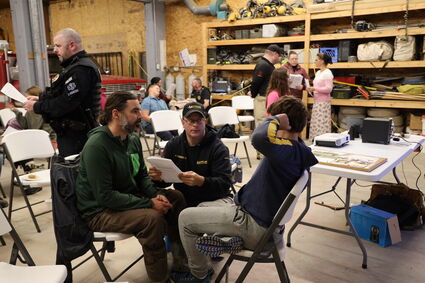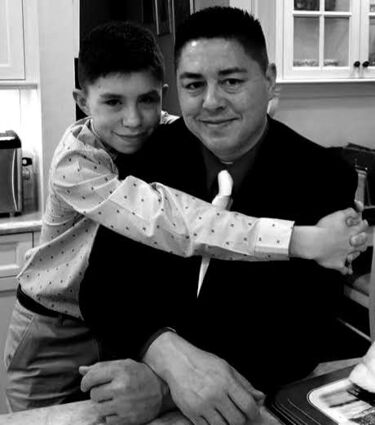EMT training includes suicide awareness, prevention info
January 27, 2022

Miriah Kardelis
Advanced EMT and owner of Whiteline Consulting and Training John Carlbom (center) participates in the QPR practice session alongside EMT in training, David Max and his son Odin in Hot Springs earlier this month.
In an effort to bring suicide awareness and prevention to the forefront of the conversation, Whiteline Consulting and Training, an Emergency Medical Service company, hosted Roosevelt County deputy sheriff Frederick Lee as part of the Hot Springs Emergency Medical Technician (EMT) training course. The public was invited to sit in on the two-hour lecture.
"How do we start a conversation about suicide," Lee asked to those in attendance. "You begin with your story." On July 27, 2018, Lee's son Michael, died by suicide. He was 13.
In the United States, there are 130 suicides per day, one every 11 minutes. "We started this training at 6:10 p.m.," Lee said. "It's now 6:24 p.m., do the math."
After the loss of his son, Lee took on the task of trying to start a suicide prevention program. The goal of the evening's training, Lee said, is to understand and prevent suicide and depression. Suicide is the 10th leading cause of death in the country.

For all age groups, Montana has ranked in the top five for suicide rates in the nation for the past 30 years. A National Vital Statistics Report from 2019 says Montana has now climbed to the third highest rating for suicides in the nation.
"Why does Montana have such a high suicide rate," Lee asked. "There are multiple factors that all occur at the same time and it is a cultural issue."
A section of the training that evening included certifying the current EMT students in the QPR method, which Lee has been a certified instructor of since 2018. QPR stands for Question, Persuade and Refer. The three simple steps anyone can learn to help save a life from suicide.
The stigma associated with depression has been attributed to one of the multiple factors as to why Montana has such a high suicide rate. Lee says people see depression as a weakness and those who deal with depression think of themselves as a burden. "If you think you are a burden, how likely are you to ask for help," he said.
"What we see with depression leading to suicide, is helplessness," said Advanced EMT and owner of Whiteline Consulting and Training, John Carlbom. "There is no escape and nowhere to go. The average lifespan of an EMT is about three years and then they quit. The first responders I have talked to who have attempted suicide or thought about it, all have the same feeling; no one to talk to and no one who understands."
Carlbom, who has been teaching for more than 20 years, says in his travels and conversations with first responders, the reasoning he has found behind an EMT only making it to three years in the career is due to depression and Post Traumatic Stress Disorder.
"We have failed as EMT instructors to bring awareness to the students that this job will have some very dark days and that it's okay not to be okay," he said. "So, I bring in suicide awareness to all my classes, hoping we can get students to stay in this career longer and be mentally healthy as well."
Along with four EMT students in training, members of Hot Springs Ambulance, Hot Springs Police Department and community members, the number of attendees was right around 20. One of the largest groups Lee has seen since he began this training course.
"This is the first time the public has been invited to a class," Carlbom said. "Suicide is such a hard topic to talk about, but this is something the whole community should be aware of. I think the biggest reason why is we don't know how to talk about it and it's been a taboo subject for so many years."
In Montana between 2008 and 2019, the highest rate of suicide was among American Indians, even though they only constitute six percent of the state's population. Caucasians came in second. The most common means of suicide in Montana are traced to firearms, which is the main method for suicide in the state. Suffocation is the second method and poisoning serves as the third most common way for suicide.
"I personally have thought about suicide and I share this with all my students," Carlbom said. "I have been on anti-depression medications for a while and I am not ashamed to be. We struggle as a society to see that suicide is a major problem and that it takes everyone to help with the suicide awareness, not just first responders."
Lee said he didn't know his son's feelings before he died by suicide and made it his mission to spread the word on suicide prevention because he does not want another family to go through what he did. Carlbom was on the call when Lee's son came into the hospital and says the experience has helped enforce compassion while on duty. "Someday, you will be working on your brother's family," Carlbom said to the evening's attendees. "For my students, take this job with compassion."
If you want a QPR presentation in your community, contact Lee at [email protected] or call (406) 839-521.
"It takes everyone to understand just how big of an issue suicide is," Carlbom said. "Most people don't think about it until it happens to their family or friends. If we can educate as many people as possible as to the signs of depression, maybe we could get these people some help before suicide is the result."
For more information on suicide prevention or for those who need help, the Suicide Prevention Crisis Text Line is a free 24/7 text line for people in crisis. Text, MT to 741-741.
You can also call the National Suicide Prevention Lifeline at 1-800-273-TALK (8255).



Reader Comments(0)